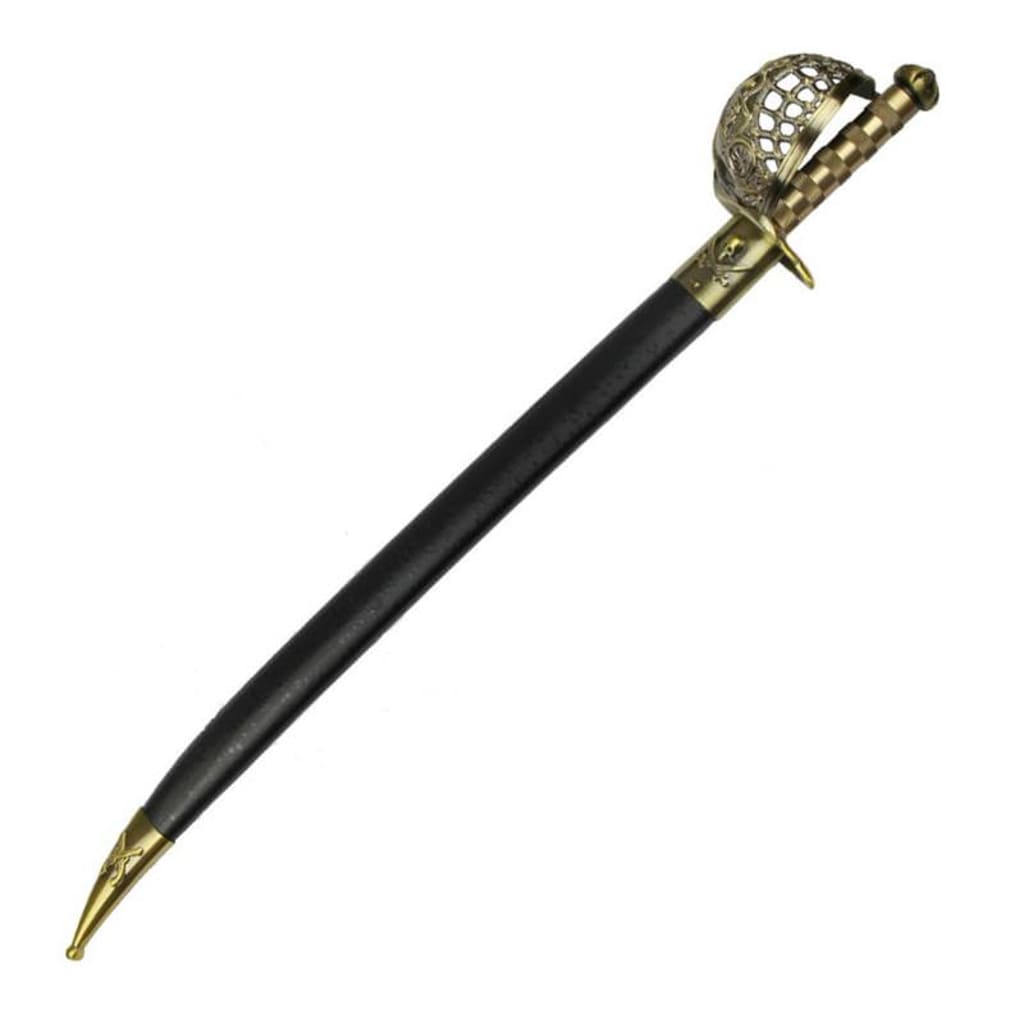Oceanic Outlaw: The Pirate Cutlass Sword
Pirate Cutlass Sword

Introduction
The pirate cutlass sword, an emblem of maritime outlaws, evokes images of swashbuckling adventures, treasure hunts, and epic battles on the high seas. This iconic weapon, with its distinctive design and historical significance, is more than just a tool of combat; it represents the rugged and rebellious spirit of pirates. In this article, we will delve deep into the history, design, and cultural impact of the pirate cutlass sword, exploring its origins, evolution, and enduring legacy.
Historical Background
Origins of the Cutlass
The cutlass, a short, broad saber with a slightly curved blade, originated in the 17th century. Its name is derived from the French word "coutelas," which means a broad knife. The design of the cutlass was influenced by earlier naval swords, such as the falchion and hanger, which were used by sailors for their versatility and effectiveness in close-quarter combat. The cutlass became particularly popular among navies and pirates alike due to its practicality aboard ships, where longer swords were cumbersome and less effective.
Adoption by Pirates
Pirates, known for their opportunistic and pragmatic approach to weaponry, quickly adopted the cutlass as their weapon of choice. Its robust construction and ease of use made it ideal for boarding actions and hand-to-hand combat. The cutlass's ability to deliver powerful slashing attacks in the confined spaces of a ship gave pirates a significant advantage over their adversaries. Additionally, the cutlass was relatively inexpensive to produce and maintain, making it accessible to pirates who often had limited resources.
Evolution Over Time
As piracy evolved and spread across the globe, so did the design of the cutlass. Variations in blade length, curvature, and hilt design emerged, reflecting the diverse needs and preferences of different pirate crews. Some cutlasses featured elaborate hilts with intricate guard designs, while others were more utilitarian in appearance. Despite these variations, the core characteristics of the cutlass—its short blade, sturdy construction, and ease of use—remained consistent, ensuring its place as a quintessential pirate weapon.
Design and Characteristics
Blade
The blade of a pirate cutlass typically ranges from 24 to 30 inches in length, making it shorter than traditional sabers but longer than daggers or knives. The slight curve of the blade allows for efficient slashing and hacking motions, which are ideal for close-quarters combat. Made from high-carbon steel, the blade is both durable and capable of maintaining a sharp edge, essential for cutting through ropes, sails, and even enemy combatants.
Hilt
The hilt of a cutlass is designed to provide a secure grip and protect the hand during combat. It usually features a cross-guard or a full guard, which can be made from brass, iron, or steel. The guard often has a distinctive knuckle bow that extends from the cross-guard to the pommel, providing additional protection and stability. The grip is typically wrapped in leather or wire, ensuring a firm hold even in wet conditions.
Scabbard
The scabbard, or sheath, of a cutlass is an important accessory that protects the blade when not in use. Made from leather or wood and often reinforced with metal fittings, the scabbard can be worn on a belt or sash, allowing for quick and easy access to the weapon. Some scabbards feature decorative elements such as engravings or embossing, reflecting the personal style of the pirate who owned the sword.
Variations
While the classic cutlass design is the most widely recognized, numerous variations exist. Some cutlasses feature straight blades instead of curved ones, while others have more ornate hilts with complex guard designs. The materials used in construction can also vary, with some cutlasses incorporating exotic materials like ivory or mother-of-pearl in the hilt or scabbard. These variations highlight the adaptability of the cutlass to different environments and combat scenarios.
Role in Pirate Culture
Symbol of Power and Authority
The cutlass was not only a practical weapon but also a symbol of power and authority among pirates. Captains and high-ranking officers often carried more elaborate cutlasses to signify their status within the crew. These weapons were sometimes adorned with precious metals and stones, serving as both functional tools and displays of wealth and prestige.
Tools of the Trade
Beyond its use in combat, the cutlass served various practical purposes on a pirate ship. Its sharp blade was used for cutting ropes, clearing brush during land expeditions, and even preparing food. The versatility of the cutlass made it an indispensable tool for pirates, who valued multifunctional equipment that could meet the demands of life at sea.
Legend and Lore
The pirate cutlass has become ingrained in popular culture and folklore, often depicted in literature, films, and art as the quintessential pirate weapon. Stories of famous pirates like Blackbeard, Anne Bonny, and Captain Kidd frequently feature the cutlass as a central element, contributing to its legendary status. The weapon's association with adventure, rebellion, and freedom has cemented its place in the collective imagination as a symbol of the pirate life.
Notable Pirates and Their Cutlasses
Blackbeard
Edward Teach, better known as Blackbeard, is one of the most infamous pirates in history. Known for his fearsome appearance and ruthless tactics, Blackbeard's cutlass was an extension of his formidable persona. His weapon of choice was a cutlass with a brass guard and a distinctive, curved blade, which he wielded with deadly precision during his numerous raids and battles.
Anne Bonny
Anne Bonny, one of the few female pirates to achieve notoriety, carried a cutlass that was both practical and symbolic of her defiance of traditional gender roles. Her cutlass was a standard naval design, featuring a sturdy iron guard and a well-balanced blade. Bonny's proficiency with the cutlass earned her respect and fear among her peers, solidifying her place in pirate history.
Captain Kidd
William Kidd, commonly known as Captain Kidd, was a Scottish pirate whose exploits captured the imagination of the public. His cutlass, often depicted in illustrations and accounts of his adventures, was a finely crafted weapon with a steel guard and an intricately decorated hilt. Kidd's cutlass symbolized his dual identity as both a privateer and a pirate, navigating the complex waters of loyalty and betrayal.
Crafting a Cutlass
Materials and Techniques
The crafting of a cutlass involves a combination of skilled blacksmithing and fine craftsmanship. The blade is typically forged from high-carbon steel, which is heated and hammered into shape before being quenched and tempered to achieve the desired hardness and flexibility. The hilt and guard are made from various metals, with brass and iron being the most common choices. These components are shaped and fitted together, often with additional embellishments to enhance the weapon's appearance.
Customization and Decoration
Pirates often personalized their cutlasses with unique decorations and modifications. Engravings, inlays, and carvings were popular ways to add a touch of individuality to the weapon. Some pirates also added practical features, such as finger rings on the guard for improved grip or weighted pommels to balance the blade. These customizations not only made the cutlass more functional but also reflected the personality and preferences of its owner.
Maintenance and Care
Maintaining a cutlass was essential to ensure its effectiveness and longevity. Pirates would regularly sharpen the blade, clean the hilt and guard, and oil the metal components to prevent rust and corrosion. The scabbard also required care, with leather being treated to keep it supple and free from cracks. Proper maintenance ensured that the cutlass remained a reliable weapon, ready for action at a moment's notice.
The Cutlass in Modern Times
Collectibles and Replicas
Today, the pirate cutlass is a popular collectible item, with enthusiasts and historians seeking out authentic antiques and high-quality replicas. These swords are prized for their historical significance and craftsmanship, often displayed in museums, private collections, and themed exhibitions. Modern replicas are crafted using traditional techniques, ensuring that they capture the essence of the original cutlasses used by pirates centuries ago.
Cultural Impact and Media Representation
The pirate cutlass continues to captivate the public's imagination, appearing in numerous books, films, and television shows. From classic literature like "Treasure Island" to blockbuster movies like "Pirates of the Caribbean," the cutlass remains an enduring symbol of pirate lore. Its representation in media often emphasizes its role as both a deadly weapon and a symbol of the pirate's adventurous and rebellious spirit.
Martial Arts and Reenactments
The art of using a cutlass has also found a place in modern martial arts and historical reenactments. Fencing schools and martial arts academies offer training in the techniques of cutlass combat, preserving the skills and strategies used by pirates. Historical reenactment groups recreate famous pirate battles and events, bringing the history of the cutlass to life for audiences around the world.
Conclusion
The pirate cutlass sword, with its distinctive design and rich history, remains an iconic symbol of the pirate era. Its practicality, versatility, and cultural significance have ensured its place in the annals of maritime history and popular culture. Whether as a weapon of war, a tool of the trade, or a symbol of power, the cutlass embodies the daring and adventurous spirit of the pirates who wielded it. As we continue to explore and celebrate the legacy of the pirate cutlass, we honor the timeless allure of the oceanic outlaws who made it famous.
Read More: What is the Karambit Knife Used for?
About the Creator
Mai Sophia
A Writer/blogger by day, a knife enthusiast and survivalist by night. I've reviewed a lot of products and have helped people make the right purchase
Enjoyed the story? Support the Creator.
Subscribe for free to receive all their stories in your feed. You could also pledge your support or give them a one-off tip, letting them know you appreciate their work.






Comments
There are no comments for this story
Be the first to respond and start the conversation.